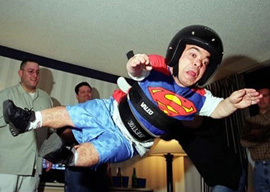
March 17, 2012

In Florida, where the sport has been banned since the 1989 death of an improperly tossed dwarf, state legislator Ritch Workman has been working to overturn the ban. While admitting that he finds dwarf tossing “repulsive,” he went on to argue that in the present economy, all the ban does is “prevent some dwarfs from getting jobs they would be happy to get…why would we want to prevent people from getting gainful employment?”
More seriously, diminutive actor Peter Dinklage (Game of Thrones) took a moment during his recent Golden Globes acceptance speech to draw attention to the strange case of Martin Henderson. Like Dinklage, Henderson is a tiny thespian who appeared to be on the verge of a promising career as an in-demand TV and movie dwarf. Then came that fateful night out celebrating his birthday last October. While minding his own business standing outside a pub, Henderson was grabbed for no discernible reason and violently thrown by a man that newspapers describe only as a “hooded thug.” Henderson is now confined to a wheelchair and blames his ordeal on the rugby players” shenanigans and the subsequent media attention given to dwarf throwing.
The above cases, along with the event in Windsor, would seem to suggest that the huge ethical dilemmas surrounding every tossed dwarf aren”t going away anytime soon. The issue is so compellingly insoluble that it once found its way to the United Nations”in the 1990s, a Gallic dwarf named Manuel Wackenheim took his case there in an effort to overturn a ban on the sport which, he argued, unjustly interfered with his right to earn a living. The little fella’s spirited defense of individual freedom was dismissed first by France’s highest court and then by the UN Human Rights Committee, who ruled that dwarf throwing was not only an affront to the dignity of dwarfs but an incitement to public disorder.
This gargantuan ethical dilemma cuts to the heart of the perpetual tug of war between individual liberty and the responsibility we bear to whatever larger collective to which we grudgingly belong. Proponents of individual freedom can convincingly argue that the anti-tossing crowd’s busybody moralism accomplishes nothing besides depriving self-determining little people of their livelihood. Meanwhile, nanny-state advocates can just as convincingly argue that such undeniably freakish spectacles bring mockery, humiliation, and degradation to not only the dwarfs themselves but, by extension, to the larger pint-sized community and, heightening the issue even further, to all of us. The giant tragedy that befell little Mr. Henderson would seem to support the “monkey see, monkey do” line of thinking already used by those who argue that pornography leads to rape or that violent video games cause random street violence. So are they right? Is it possible that rubber-stamping the government’s approval onto every tossed dwarf’s disproportionately large head could lead members of the height-impaired community to be abused by members of the brain-impaired community?
There are no easy answers to this puzzle. And those of us who suffer from both an irrational fear and loathing of dwarfs and an implacable disdain for the kind of ball-cap-wearing morons who would pay to toss them around or to watch them being tossed”well, we are surely in no position to answer these profound ethical queries. But on the general subject of exploitation, the final word should go to an anonymous midget-hurler who attended the Leopard’s Lounge event. When confronted by a hand-wringing Toronto Star journalist about the ethical implications of taking part in a dwarf toss, he shrugged and said, “I feel no more socially guilty than when I normally come out of a strip club.”